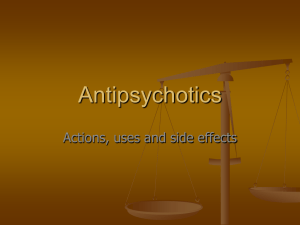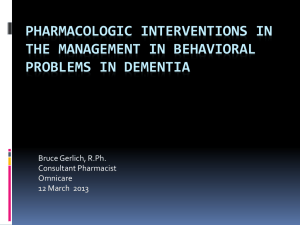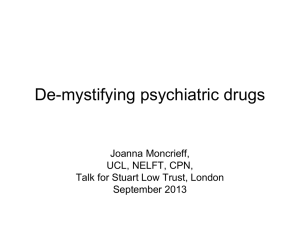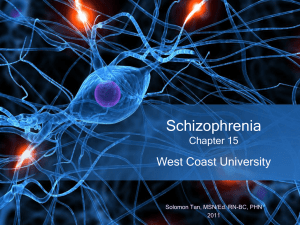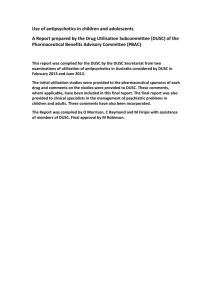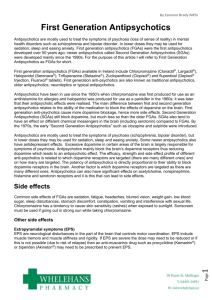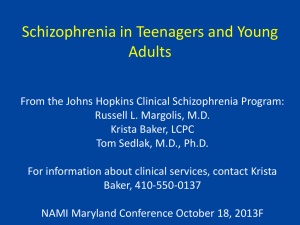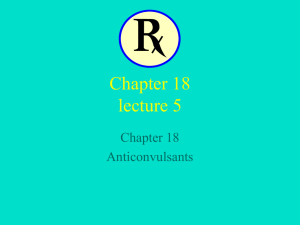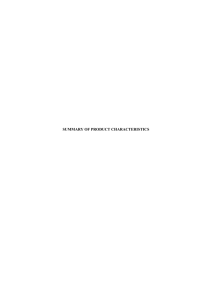Antipsychotic Medications in the Primary Care Practice
advertisement
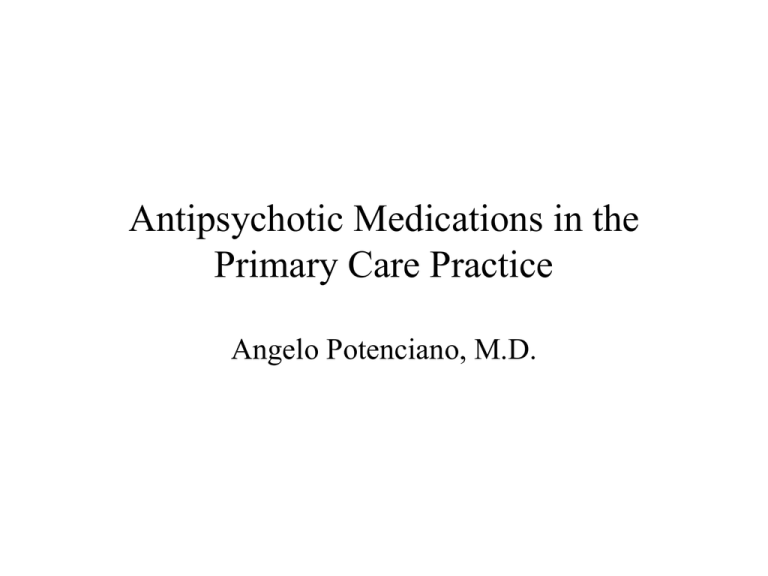
Antipsychotic Medications in the Primary Care Practice Angelo Potenciano, M.D. Antipsychotic Medications • Antipsychotics have been around since 1951 • Approximately 40 APs in the market globally • 15 are Typical APs / “Neuroleptics • 21 are Atypical APs – 9 are in the U.S. Antipsychotics in the Primary Care Setting • Lieberman (2002) noted that PCP Rx Of APs has increased 18-20% since 1996 PCPs treat a variety of psychiatric disorders including depression, anxiety, bipolar disorders, sleep disorders, psychosis, and behavioral problems assoc. with dementia, and delirium Reasons Why PCPs Are Vital in the Treatment of Psychiatric Patients • Not enough psychiatric services available • Psychiatric symptoms arising from medical d/o or during the course of treatment • Patients are more comfortable seeing their PCP • Stable Patients who require maintenance meds History of Antipsychotics • 1891 – Paul Ehrlich and Paul Guttman pioneered the use of Methylene Blue –a phenothiazine derivative in the Tx of Malaria • 1890s- noted the tranquilizing and antidepressant effects • Became the lead compound in the development of Chlorpromazine History of Antipsychotics • 1951 –French surgeon, Henry Leborit used Chlorpromazine as a sedating agent • 1952 John Delay and Pierre Deniker treated 38 schizophrenics with CPZ 75100mg/day/IM • Dramatic improvements in thinking and emotional symptoms and overall behavior History of Antipsychotics • 1954-1975 development of typical Aps Thioridazine – Mellaril Haloperidol- Haldol Trifluoperazine- Stelazine Perphenazine- Trilafon Fluphenazine- Prolixin Molindone-Moban Pimozide History of Antipsychotics • 1980s-Janssen developed Risperidone • The earliest Atypical APs • Followed the LSD model of psychopathology- Risperidone-antagonized effects of LSD History of Antipsychotics • 1989 Clozapine was approved by the FDA In treating treatment-resistant schizophrenia 1971 introduced in Europe but was withdrawn in 1975 due to angranulocytosis Atypical Antipsychotics Aripiprazole- Abilify Asenaphine- Saphris Clozapine- Clozaril Iloperidone- Fanapt Lurasidone- Latuda Olanzapine- Zyprexa Risperidone- Risperdal Quetiapine- Seroquel Ziprasidone- Geodon Mechanism of Action of Antipsychotics • Dopamine antagonist- D1-4 R • Typical APs / Neuroleptics- D2R (tightly bound) • Atypical Aps- D1 & 2R (loosely bound or rapid dissociation), 5HT 2A and 5HT2C Mechanism of Action • D2R antagonism – EPS (akatishia, dystonia, parkinsonism, tardive dyskinesias) • Rapid dissociation from DA receptor- less EPS risk • 5HT binding(2A) – mood and cognitive effects, decreased DA blockade Clinical Uses of Antipsychotics FDA Approved Indications 1. Psychotic symptoms due to Schizophrenia or Schizoaffective disorder 2. Mood disorders: Bipolar disorder and Major depressive disorder Clinical Uses of Antipsychotics “Off-Label” or Non-FDA Approved 1. Psychotic symptoms of various etiologysubstance-induced, dementia, delirium 2. Behavioral problems secondary to developmental disorders (autism, ADHD), dementia, delirium, other neurological disorders 3. Sleep disorders 4. Anxiety disorders Antipsychotics and Schizophrenia -First-line psychiatric treatment -psychotic symptom reduction in 1-2 weeks -almost 80% response rate (partial – good) -choice is based on cost, side effects / safety, dosing Clinical Uses of Antipsychotics • FDA Approved Indications Schizoaffective Disorder- Iloperidone (Fanapt) Treatment-Resistant Schizophrenia (failure to respond after 6 weeks of trials with 2-3 different antipsychotic- Clozapine (Clozaril) Clinical Uses of Antipsychotics • FDA Approved Indications Bipolar Disorder: Asenapine, Aripiprazole, Lurasidone, Olanzapine, Quetiapine, Risperidone, Ziprasidone Antipsychotics and Bipolar Disorders FDA Approved Indications Bipolar disorder-Mixed or Manic Episode: Asenapine, Aripiprazole, Olanzapine, Quetiapine, Risperidone, Ziprasidone Bipolar Disorder- Depressive episode: Lurasidone, Olanzapine-Fluoxetine (symbyax), Quetiapine Monotherapy or adjunctive therapy with Lithium or valproate Antipsychotics and Bipolar Disorder • Clinical Advantages: 1. does not require blood levels (Valproate, lithium) 2. safer in patients with co-morbid substance abuse, liver/kidney diseases 3. Safer in overdoses / toxicities Injectable Antipsychotics Acute agitation associated with Schizophrenia or Bipolar Disorder: Haloperidol, Olanzapine, Ziprasidone Antipsychotics Use in Children Bipolar disorder in children and adolescents (aged 10-17) (Monotherapy): Quetiapine, Risperidone Schizophrenia in Adolescents (aged 13-17): Aripiprazole, Risperidone Behavioral issues associated with Autistic d/o (irritability, aggression, self-injurious beh.,temper tantrums, rapidly changing moods): Risperidone, Aripiprazole Antipsychotics and Depressive Disorders Treatment-Resistant Depression: Olanzapine-Fluoxetine Combination Adjunctive / Augmentive Treatment of Major Depression: Aripiprazole, Quetiapine XR Off-Label Uses of Antipsychotics • Behavioral issues associated with Dementia and Delirium: agitation/ aggression, psychosis, sleep disturbances, anxiety, confusion • Increasing consensus in the efficacy of APs • Atypical APs-less EPS and anticholinergic effects • Haloperidol (low doses) as safe and effective as atypical APs Antipsychotics for Dementia Clinical Antipsychotic Trials of Intervention Effectiveness-Alzheimer’s Disease 2008 (CATIE-AD): Effectiveness of Olanzapine, Quetiapine, Risperidone in improving anger, aggression, paranoia / hostile suspiciousness but NOT overall functioning, care needs, and quality of life Antipsychotics for Delirium • Haloperidol- antipsychotic of choice (Society of Critical Care Medicine 2007) • Risk of EPS and Cardiac Conduction Changes • Olanzapine, Quetiapine, Risperidone- as efficacious, with less side effects, quicker improvement, less agitation, better sleep patterns Antipsychotics in the Elderly • 1.6-1.7 times risk of death in patients taking APs • Duration of treatment: 10 weeks • Common causes: sudden death, CV-Heart failure, infectious (pneumonia) • 1.7-2 times risk of CVAs in dementia patients taking Antipsychotics Off-label Uses of Antipsychotics • Sleep disorders—sedative effects of Aps can promote sleep • Most sedating APs: Olanzapine, Quetiapine, Chlorpromazine, Thioridazine Metabolic and EPS side effects are concerns in long-term use Off-label Uses of Antipsychotics • Anxiety disorders / symptoms—OCD, GAD, Panic Disorders • tranquilizing / anxiolytic effects of most APs used in combination with SSRIs or Benzos. –Mostly inconclusive study results • May be more useful in patients with comorbid disturbances or psychosis Tourette’s Disorder • Risperidone and Pimozide—best evidence • Aripiprazole-promising data; lower risk for side effects Side Effects • EPS-Parkinsonian, Dystonia, Akatishia,Tardive Dyskinesia • Elderly patients are at higher risk for EPS and TDs –develops more readily and are more persistent • Mostly seen in use of Conventional APs or neuroleptics and Risperidone Side Effects • Metabolic: weight gain, hyperglycemia, hyperlipidemia Most likely to cause Metabolic side effects: Olanzapine, Quetiapine, Risperidone Less Likely: Ziprasidone, Asenapine, Lurasidone Side Effects • Prolonged QTc Interval and Sudden Death: • Most APs will carry this risk (Haloperidol, Droperidol, Pimozide) • Highest risk: Thioridazine Ziprasidone (no evidence yet to suggest that this leads to sudden death)


